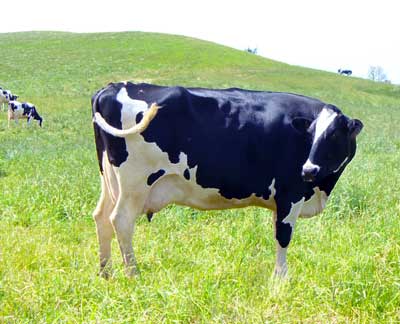Eating Full Fat Dairy Lowers Incidence of Diabetes by 62%
And Fun Facts About Brain Freeze!
Short Summary: Push away that glass of bluish low fat milk and grab a delicious creamy carton of full fat yogurt to reduce your risk of type 2 diabetes. A healthy fat, trans-palmitoleic acid, found in full fat dairy products reduces the incidence of type 2 diabetes.

Picture: A happy Holstein dairy cow with a perfect BMI (for a cow) swishes her tail in a green pasture.
Mozaffarian et al. (2010) analyzed a group of 3,736 people in the Cardiovascular Health Study over 20 years. They found that people with the highest blood levels of trans-palmitoleic acid had a 62% lower chance of contracting diabetes than people with the lowest levels of trans-palmitoleic acid.
There was a direct correlation between people's intake of dairy and their trans-palmitoleic concentrations (the more dairy they ate the higher their blood levels of trans-palmitoleic). In addition, the risk of diabetes changed incrementally; as people ate more trans-palmitoleic acid they were less likely to develop diabetes.
People with a higher consumption of trans-palmitoleic acid were also slightly leaner, had higher HDL (good) cholesterol, lower total cholesterol-HDL ratio, less inflammatory compounds (C-reactive protein), and improved insulin sensitivity. All of these changes are positive and reduce the risk of diabetes and other metabolic disorders.
Eating more dairy in general can reduce your risk of developing insulin resistance syndrome (IRS) also known as metabolic syndrome. People who consumed 3-4 servings of dairy a day had a 71-72% less chance of developing IRS compared to those who only ate 0.9-1.7 servings of dairy each day (Pereira et al. 2002, Tremblay and Gilbert 2009). For more on this topic, see our page on how dairy prevents metabolic syndrome. Tong et al. (2011) also reported that dairy consumption lowered the risk of developing type 2 diabetes.
Trans-palmitoleic acid is found in full fat dairy products like yogurt, milk, butter, cheese, as well as products made with full fat dairy like some desserts (take that low fat cookies!). In a second study, Mozaffarian et al. (2013) assessed 2,617 adults of mixed races/ethnic groups. They found that higher trans-palmitoleic acid consumption raised LDL cholesterol slightly but also lowered triglycerides, decreased fasting insulin, lowered systolic blood pressure and reduced the risk of diabetes by 48% compared to lower consumption of trans-palmitoleic acid.
Why Does Trans-Palmitoleic Acid Prevent Type 2 Diabetes?
Cis-palmitoleic acid is produced by adipose tissue (fat). Cis-palmitoleic acid is similar to trans-palmitoleic acid but with a different bond configuration. Animal studies have shown that cis-palmitoleic acid may regulate and prevent insulin resistance and other metabolic disorders (Cao et al. 2008). Metabolic disorders include inflammation, high blood pressure, fatty abdomen, and high triglycerides.
Although further work needs to be done, scientists believe that trans-palmitoleic acid works in a similar way by partially inhibiting the liver's production of fat (Mozaffarian et al. 2010). It may also influence lipid epigenetics and/or metabolism.
Dairy Intake Protects Against Type 2 Diabetes
Eating dairy also protects you from type 2 diabetes. Three recent meta-analysis studies found that a high intake of dairy products was associated with a significant decrease in the risk of type 2 diabetes (Tong et al. 2011, Gao et al. 2013, Aune et al. 2013).
A meta-analysis is a study that analyzes a group of other original research studies to see if there are any patterns.
More Reasons Whey Prevents Diabetes
A small human trial reported that consuming whey protein before meals reduces post meal blood sugar spike while improving insulin response. It may do this by stimulating production of a gut hormone called glucagon-like peptide-1 (GLP-1) (Jakubowicz et al. 2014).
Drinking milk with a high carbohydrate breakfast reduces blood glucose even after lunch compared to drinking water (Kung et al. 2018). High protein milk (milk with either whey or casein protein added) worked even better.
Oleic Acid Also Prevents Type 2 Diabetes
Oleic acid, another dairy fat, reverses inflammation related insulin dysfunctions that can contribute to diabetes (Vassilious et al. 2009). Chronic inflammation can be caused by obesity. Fat cells produce tumor necrosis factor-alpha, TNF-α, which reduces insulin secretion and causes insulin resistance. Vassilious et al. (2009) reported that in a cell model, oleic acid enhanced insulin production. Likewise, in type 2 diabetic mice, a diet high in oleic acid helped ameliorate the effects of their disease (Vassilious et al. 2009).
Fun Fact About Brain Freeze:
Are there any down sides to consuming a delicious bowl of cold ice cream? Unfortunately, chowing down on ice cream too quickly can cause brain freeze. Luckily, neuroscientists at Wake Forest Baptist Medical Center (2013) have discovered why brain freeze occurs.

Brain freeze or sphenopalatine ganglioneuralgia (which is what its mom calls brain freeze when it is in trouble) is caused when cold food decreases the temperature at the back of the throat rapidly. This chills both the juncture of the internal carotid artery, which brings blood to the brain, and the anterior cerebral artery, which marks the start of the brain tissue. Where these two arteries meet is the meninges, or outer covering of the brain. Receptors at the meninges sense that the arteries are contracting due to the cold and your brain interprets this as pain.
To prevent brain freeze take the time to savor your ice cream instead of gulping it down. Swilling down a warm drink will also stop brain freeze in its tracks by warming up the blood vessels and stopping the contraction. No warm drink handy because it is 100 °F in the shade? Try pressing your tongue against the roof of your mouth to warm up the back of your throat.
References:
Aune D, Norat T, Romundstad P, Vatten LJ. Dairy products and the risk of type 2 diabetes: a systematic review and dose-response meta-analysis of cohort studies. Am J Clin Nutr. 2013;98:1066-83. Pubmed. doi: 10.3945/ajcn.113.059030. Cao H, Gerhold K, Mayers JR, Wiest MM, Watkins SM, Hotamisligil GS. Identification of a lipokine, a lipid hormone linking adipose tissue to systemic metabolism. Cell. 2008;134:933-44. Pubmed. doi: 10.1016/j.cell.2008.07.048 (full text) Gao D, Ning N, Wang C, Wang Y, Li Q, Meng Z, Liu Y, Li Q. Dairy products consumption and risk of type 2 diabetes: systematic review and dose-response meta-analysis. PLoS One. 2013;8:e73965. Pubmed. doi: 10.1371/journal.pone.0073965 (full text) Jakubowicz D, Froy O, Ahrén B, Boaz M, Landau Z, Bar-Dayan Y, Ganz T, Barnea M, Wainstein J. Incretin, insulinotropic and glucose-lowering effects of whey protein pre-load in type 2 diabetes: a randomised clinical trial. Diabetologia, 2014; 57 : 1807. doi: 10.1007/s00125-014-3305-x Kung B, Anderson GH, Paré S, Tucker AJ, Vien S, Wright AJ, Goff HD. Effect of milk protein intake and casein-to-whey ratio in breakfast meals on postprandial glucose, satiety ratings, and subsequent meal intake. Journal of Dairy Science. 2018; doi: 10.3168/jds.2018-14419 Mozaffarian D, Cao H, King IB, Lemaitre RN, Song X, Siscovick DS, Hotamisligil GS. Trans-palmitoleic acid, metabolic risk factors, and new-onset diabetes in U.S. adults: a cohort study. Ann. Intern. Med. 2010 Dec 21;153(12):790-9. Pubmed. doi: 10.1059/0003-4819-153-12-201012210-00005 (full text) Mozaffarian D, de Oliveira Otto MC, Lemaitre RN, Fretts AM, Hotamisligil G, Tsai MY, Siscovick DS, Nettleton JA. Trans-Palmitoleic acid, other dairy fat biomarkers, and incident diabetes: the Multi-Ethnic Study of Atherosclerosis (MESA). Am J Clin Nutr. 2013;97:854-61. Pubmed. doi: 10.3945/ajcn.112.045468 Pereira MA, Jacobs DR Jr, Van Horn L, Slattery ML, Kartashov AI, Ludwig DS. Dairy consumption, obesity, and the insulin resistance syndrome in young adults: the CARDIA study. JAMA. 2002;287:2081-9. Pubmed. Tong X, Dong JY, Wu ZW, Li W, Qin LQ. Dairy consumption and risk of type 2 diabetes mellitus: a meta-analysis of cohort studies. Eur J Clin Nutr. 2011;65:1027-31. Pubmed. doi: 10.1038/ejcn.2011.62 Tremblay A, Gilbert JA. Milk products, insulin resistance syndrome and type 2 diabetes. J Am Coll Nutr. 2009;28:91S-102S. Pubmed. Vassiliou EK, Gonzalez A, Garcia C, Tadros JH, Chakraborty G and Toney JH. Oleic acid and peanut oil high in oleic acid reverse the inhibitory effect of insulin production of the inflammatory cytokine TNF-α both in vitro and in vivo systems. Lipids in Health and Disease 2009;8:25. Pubmed. doi: 10.1186/1476-511X-8-25 (full text)
